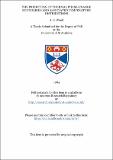Files in this item
The prediction of thermal phase-change boundaries and associated temperature distributions
Item metadata
| dc.contributor.advisor | Bell, G. E. | |
| dc.contributor.author | Wood, A. S. | |
| dc.coverage.spatial | 236 p. | en_US |
| dc.date.accessioned | 2018-06-07T10:25:38Z | |
| dc.date.available | 2018-06-07T10:25:38Z | |
| dc.date.issued | 1984 | |
| dc.identifier.uri | https://hdl.handle.net/10023/13797 | |
| dc.description.abstract | The past three decades have seen a fast expanding interest in thermal problems exhibiting a change of phase, more commonly known as Stefan problems. With the rapid advance in computer technology the use and expansion of numerical simulation schemes has been responsible for large advances in this field. The increasing size of computers has led to more sophisticated and complex numerical solutions becoming feasible from a computational point of view. On the other hand, part of this interest has developed from industrial quarters where a knowledge of the location of a melting/freezing boundary may be of critical importance for certain processes. Much experimental work has been completed in this field. However, it is still useful to be able to obtain quick, accurate numerical solutions to such problems and it is with this in mind that this thesis is presented. Ideas from both of the above areas of interest are treated. In the first case a simple to program and computationally efficient numerical scheme is proposed for solving one dimensional Stefan problems and its merits are discussed in relation to several of the more common existing solution schemes. This scheme is then modified to cater for a two dimensional problem which crudely imitates a possible heating configuration in some industrial processes. The problem, with its attendant difficulties, is first approximated by a 'test' problem which is constructed so as to admit an analytic solution. This allows assessment of the numerical procedure in two dimensions. In the course of this work a pseudo-analytic solution was obtained for the original two dimensional problem. Finally, in collaboration with the British Gas Corporation, a complex industrial freezing problem is discussed concerning the flow of liquid through an enclosed channel. Some simplifying assumptions are proposed to reduce the problem to a form for which a relatively simple numerical scheme may be adopted. Several simulations are completed to examine the effect of varying physical parameters on the solution and in particular to test for situations of blockage or steady-state. | en_US |
| dc.language.iso | en | en_US |
| dc.publisher | University of St Andrews | en |
| dc.subject.lcc | QA379.T7W7 | |
| dc.subject.lcsh | Boundary value problems | en |
| dc.title | The prediction of thermal phase-change boundaries and associated temperature distributions | en_US |
| dc.type | Thesis | en_US |
| dc.contributor.sponsor | Science and Engineering Research Council (SERC) | en_US |
| dc.contributor.sponsor | British Gas Corporation | en_US |
| dc.type.qualificationlevel | Doctoral | en_US |
| dc.type.qualificationname | PhD Doctor of Philosophy | en_US |
| dc.publisher.institution | The University of St Andrews | en_US |
This item appears in the following Collection(s)
Items in the St Andrews Research Repository are protected by copyright, with all rights reserved, unless otherwise indicated.

